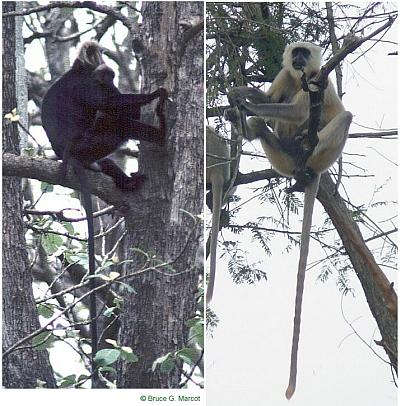 |
|
|
|
|
Click on the image for a larger version
 |
|
|
|
right: Common Langur - Himalayas, northern India |
Credit & Copyright: Dr. Bruce G. Marcot
| Explanation:
Paternal
twins? In a sense. These are different species of langur,
two of the 15 species of primates found in India.
On the left is the threatened Nilgiri Langur (Presbytis [=Trachypithecus] johnii), a shy primate found only in the dense primary rainforests of the Western Ghats mountains of southern India, including the Nilgiri Mountains. The Nilgiri Langur is mostly arboreal, although I have photographed it scampering across the ground as well as making amazing suicidal leaps across tree canopies. In one of the few studies on this species, Nilgiri Langurs were found to eat mostly leaves (48% of the diet), seeds (19%), fruit (15%), flowers (8%), and other minor items. They are a good indicator of intact rainforest with contiguous tree canopies, and are threatened by habitat destruction including forest cutting. Nilgiri Langurs inhabit the dense "core areas" of biosphere forest reserves and also venture out into the more intact surrounding forests. Their appearance near villages marks forests that likely also have rich non-timber forest products used by villagers and local tribespeople. It is truly a indicator of intact and healthy forest ecosystems. Its cousin on the right is a Common Langur (Presbytis entellus), found widely throughout the greater Indian Subcontinent. It is more tolerant of forest openings and disturbances, and spends much of its time foraging on the ground for shoots, leaves, flowers, buds, and fruits. It is also called the Hanuman Langur, and is protected in the Hindu religion as the monkey god Hanuman as written of in the Hindu epic "Ramayana." The Common Langur is often a commensal (partner) with humans, and Its appearance is a good sign from both an ecological and religious standpoint. |
Next week's picture: Vegetable Caterpillar!
Member Theme of Taos-Telecommunity